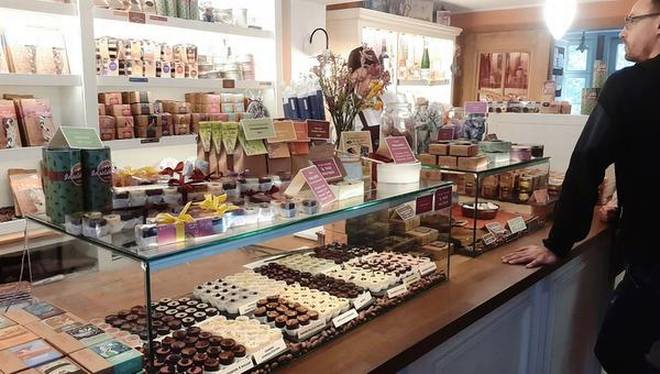Red and white, yellow and brown, grey and blue — houses on Merchant’s Bridge or Kramerbrucke are colourful. But they have no numbers. Or addresses. Even the street is nameless. What they do have are symbols; bright, prominent and distinct red stars, golden helmets and golden canes stare back at you from these vibrant chock-a-block homes.
Tap on any of them and you may get to hear a hollow whisper that takes you back 500 years. Known as half timber houses, the peculiarity of their construction is that within the timber frame, hay and clay are placed in order to keep the house warm during the bitter cold German winters. Of the original 62, 32 remain and enjoy special protection. Gothic, renaissance and baroque — they are all here on the 120-metre-long Merchant’s Bridge in Erfurt, capital of the state of Thuringia in Germany.
“Try our chocolate truffles. You won’t regret it,” says the server standing on the stone cobbled bridge outside Goldhelm Schokolade, a homemade chocolate manufacturer. He deliberately extends a grey stone slab on which brown chocolate-dusted cubes of sample truffles beckon. Goldhelm Schokolade happens to be a local success story gone viral with their truffles, pralines, hot chocolate and ice cream being sold out in a few hours.
Named after the merchants who were the crème de la crème of the bridge in its heyday, today artistic displays rule and conquer Merchant’s Bridge. Potters, glass blowers, a felt maker, woodwork sculptors and porcelain manufacturers vie ethically for coveted space on Kramerbrucke.
The picture-perfect bridge houses model cafés, shops and studios that co-exist with residents and their poodles. But if you really want some drama, step into Haus der Stiftungen, which is less of a house and more of a permanent exhibition on Kramerbrucke.
A couple of centuries ago, near the ford across the River Gera, two prominent trading places needed to be connected. Thus was born Merchant’s Bridge that played its role in Erfurt’s prosperity. Said to be the longest European bridge with inhabited houses on its entire span, the original structure was made of wood, easy to source and build with, but equally easy to burn. Which is exactly what happened. Fire upon fire razed the bridge to cinders. And each time, the resilient townspeople rebuilt it and life returned to normal.
But prudence prevailed in 1325, after another blaze. Fire-resistant materials (in comparison to wood), like sand and stone, were used. Six vaulted arches were constructed with two churches built at each end of the bridge — St Benedict’s Church at the western end and St Agidien’s Church at the east.
But the stubborn fires were not done with Erfurt and challenged its sand and stone construction yet again in 1472. This time, Erfurt’s residents expanded the bridge, and caught in the heat of the moment, built 62 half-timbered houses as well.
Erfurt painted Europe blue with its superior quality of the woad plant, used for dyeing. Today, the odd woad in a pot reminds residents and visitors of a time gone by.








